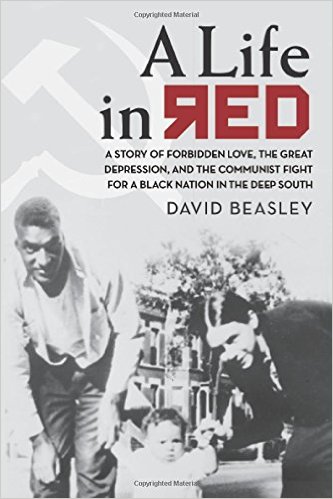
The struggle for working-class unity is a running theme throughout the tapestry of U.S. radical history. Especially important is developing an understanding of working-class unity that bridges race and sex. While this observation is true for the nation as a whole, its significance is even more profound when viewed through the lens of the struggle against Southern racism, slavery and Jim Crow.
David Beasley’s A Life in Red: A Story of Forbidden Love, The Great Depression, and the Communist Fight for a Black Nation in the Deep South – as the title suggests – promises a deeper understanding of this complex and fluid history. Unfortunately, it delivers considerably less.
While I appreciate Beasley’s effort to bring attention to the lives of Herbert Newton, a working-class African American man one generation removed from slavery, and Jane Emery, an upper middle-class white daughter of an American Legion commander – both one-time leaders of the Communist Party, USA – I can’t in good conscience recommend A Life in Red.
The book is an incomplete narrative with hardly enough biographical information on the Newtons – their life, marriage and political struggles – to warrant a book-length treatment. While there are bits of interesting detail sprinkled throughout the 146 pages of actual text, Beasley seems unable to build more than a peripheral foundation for his “story.”
I don’t envy Beasley’s situation, as there is probably sparse archival material on the Newtons. Further, A Life in Red contains little new or original research on the Black Nation thesis, or communist organizing during the Depression – in the Deep South or elsewhere. (The Black Nation was the CPUSA proposition, held for a brief time in the 1920s and ’30s, that those counties in the Deep South with a majority Black population, constituting a broad continuous swath of territory across several states, should be entitled to national recognition along the lines laid down by theorists of the “national question” in the USSR.)
Often, A Life in Red seems to be more focused on Richard Wright, Harry Haywood, Ben Davis and Angelo Herndon, their far more documented stories and lives as communists, and how they intersect with the Newtons, and Benjamin Mays, who later became president of Morehouse College. Yet even outside these connections, things happened in the Newtons’ lives that would make for a riveting biography; but Beasley skates past them or leaves them underdeveloped.
In 1926, at age twenty-two, Newton joined the CPUSA. Like many African Americans, he was attracted to the Party due to its leadership in the struggle against racism. Only a year later, Newton – with a handful of other U.S. communists – was in the Soviet Union, studying at the Communist University of the Toilers of the East, or KUTV.
“Newton saw a Soviet Union brimming with optimism,” writes Beasley, “a nation that was building entire cities around massive factories for farm equipment and other machinery. The redistribution of wealth under Communism modernized and mechanized the Soviet Union in a massive economic transformation.”
Newton spent six months at KUTV and then started his studies at the Lenin School, where he remained for the next two and a half years before returning to the United States.
After returning home, Newton became a full-time Party organizer, was sent south to Georgia, where he worked with other communists, like Ann Burlak, a leader in the Party-led National Textile Workers’ Union. Eventually Newton would join Burlak and four other communists in an Atlanta jail, charged with insurrection and facing the death penalty. They collectively became known as the Atlanta Six.
After his release, Newton “returned to the world of Communist agitation and propaganda,” becoming a “folk hero, as evidenced by a rally of 2,500 people in New York’s Union Square,” says Beasley.
Jane Emery’s path to the CPUSA was more academic. She studied the “fathers of Communism, Karl Marx and Friedrich Engels. She concluded that the Communist Party was ‘the most reliable organization for attaining the greatest happiness for the greatest number of people,'” and officially joined the Party in 1931. Shortly thereafter, she started working for International Labor Defense, the Party’s legal arm defending the Atlanta Six, Angelo Herndon and the Scottsboro Boys, among others, led by William Patterson.
According to Beasley, “Jane and Herbert became good friends and attended forums and lectures in Chicago. Newton told Jane about his time in the Soviet Union and the ‘absence of discrimination against men because of their race or nationality.'” Their courtship began in 1932. By early 1933 Jane was pregnant, and in September they married.
As Beasley says, “The life of a revolutionary was not a glamorous one.” Emery recalled later in life, “Many people imagine that communists go around plotting, sneaking, making bombs and inciting violence…. Quite the contrary. Our occupations were teaching and speaking with people…. No change will be possible until the majority of the people feel that a change is necessary.”
After being evicted from their South Chicago apartment, the Newtons and other communists protested, were charged with disorderly conduct and fined $200 – money they did not have.
However, while Herbert went to jail on the disorderly conduct charge, the judge “spared” Jane and “ordered her to undergo a psychiatric evaluation, on the obvious premise that a daughter of such a prominent white family would have to be insane to turn her back on such an upbringing to marry a black communist,” hence the “forbidden love” portion of Beasley’s book.
Undoubtedly, Herbert and Jane Newton had an interesting story. But while Beasley has introduced us to these remarkable people and should be applauded for that, A Life in Red is just an introduction. The biographical data on the Newtons could easily have been condensed into one-fourth of the 146 pages of text, which might have been perfect as an article in a historical journal or as part of a larger compilation of essays on communist activism during the 1930s. Further, the biographical information on Wright, Haywood, Davis and Herndon is easily found in better, more nuanced books and articles elsewhere.
While I encourage readers to learn more about the Newtons, the Black Nation thesis and communist organizing in the Deep South, I don’t think A Life in Red is worth the $20 asking price.
A Life in Red: A Story of Forbidden Love, The Great Depression, and the Communist Fight for a Black Nation in the Deep South
By David Beasley
John F. Blair, Publisher, 224 pages
$20.00

MOST POPULAR TODAY


Zionist organizations leading campaign to stop ceasefire resolutions in D.C. area

High Court essentially bans demonstrations, freedom of assembly in Deep South

Communist Karol Cariola elected president of Chile’s legislature

Afghanistan’s socialist years: The promising future killed off by U.S. imperialism






Comments